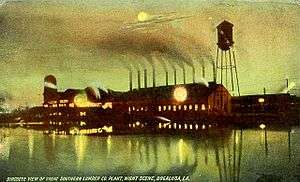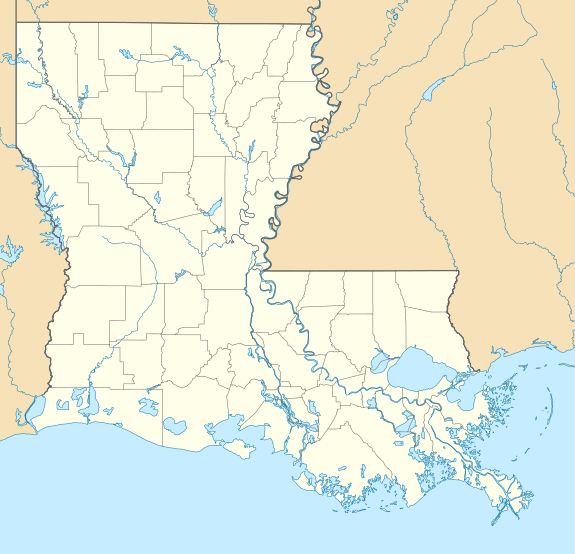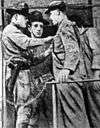Bogalusa sawmill killings
The Bogalusa saw mill killings was a racial attack that killed four labor organizers on November 22, 1919. It was mounted by the white paramilitary group the Self-Preservation and Loyalty League (SPLL) in Thibodaux, Louisiana. They were supported by the owners of Great Southern Lumber Company, a giant logging corporation, that hoped to prevent union organization and the Black and White labor organizations from merging.
Background
Great Southern Lumber Company
The Great Southern Lumber Company was chartered by the Goodyear family in 1902 to harvest and market the virgin longleaf pine (Pinus palustris L.) forests in southeastern Louisiana and southwestern Mississippi. Bogalusa, Louisiana was developed from the ground up as a company town and was the location for Great Southern Lumber Company's sawmill, which began operation in 1908. Other company interests included a railroad and paper mill. The company ceased operation in 1938 when the supply of virgin pines was depleted. Bogalusa became the site of a paper mill and chemical operations, followed by other industry. The Great Southern Lumber Company was the largest sawmill in the world from its opening in 1908, until 1938, when it ceased operation.[1] Even though the company had made incredible profits supporting the war effort its workers still only made 30 cents an hour ($8 in 2020).[2]
Racial violence
On August 31, 1919, Black veteran Lucius McCarty was accused of assaulting a white woman and a mob of some 1,500 people seized McCarty and shot him more that 1000 times. The mob then dragged his corpse behind a car through the black neighborhoods before burning his body in a bonfire. [3] [4]
Union organization
Lum William was able to merge a number of Unions into the Central Trades Assembly. They then asked the sawmill for formal recognition in September of 1919. The company fired many of the union organizers and banned company stores, almost all of the stores in Bogalusa, from selling union members goods. The workers went on strike and the company brought in Black strikebreakers from New Orleans.[2] This use of Black, out of town, labours increased racial tension in the town.
Attack
The Bloody Bogalusa Massacre occurred on November 22, 1919, after years of struggle when workers in the timber industry were trying to organize. That year there had been earlier armed conflicts in town and some 200 black workers were forced out. The sawmill at Bogalusa was the largest complex in the world. [1] To offset labor demands for better wages, the town police arrested black men nightly for minor offences and brought them at gunpoint to be forced labor at the mill. If any were too sick or refused to work, they were beaten. While the International Union of Timber Workers had sections for blacks and whites, four white union men died in this incident while defending Sol Dacus, the head of the black union. It was a highlight of interracial union support.[5]
Dacus's house was shot up the night before but he and his family escaped injury in the attack. The next day, he showed up at work, flanked by white workers. The company called out 150 deputies of its large, private militia against unrest. It blew the whistle to signal a riot and attempted to arrest J. P. Bouchillon and Stanley O’Rourke, who were carrying shotguns. While the company claimed the unionists shot first, other eyewitness accounts contradicted them. The white men Bouchillon, O'Rourke, Lem Williams, president of the Central Trades and Labor Council; and carpenter Thomas Gaines were all killed. Two black men were also killed, and the unionization effort suffered. When black workers at the sawmill attempted to organize a labor union, and were gunned down by the largest private army in Louisiana.[6] [5]
William H. Sullivan had been appointed by the Goodyear brothers to serve as general manager of the Great Southern Lumber Company. Sullivan was also mayor of Bogalusa.[7] [8] Social order was restored when the Louisiana Governor requested the deployment of federal troops in Bogalusa. Five officers and 100 troops arrived to secure Bogalusa for one month, under the leadership of Major General Henry G. Sharpe. [9] After this period, interracial union cooperation declined with the rise of AFL craft unions, which had segregated locals. In addition, labor organizing was tainted by government fears about communist and socialist activities after World War I.
Aftermath
This labor action was among several incidents of civil unrest that are now known as the American Red Summer of 1919. Attacks on black communities and white oppression spread to more than three dozen cities and counties. In most cases, white mobs attacked African American neighborhoods. In some cases, black community groups resisted the attacks, especially in Chicago and Washington, D.C. Most deaths occurred in rural areas during events like the Elaine race riot in Arkansas, where an estimated 100 to 240 blacks and 5 whites were killed. Other major events of Red Summer were the Chicago race riot and Washington D.C. Race Riot, which caused 38 and 39 deaths, respectively. Both riots had many more non-fatal injuries and extensive property damage reaching up into the millions of dollars.[10]
See also
| Wikimedia Commons has media related to Bogalusa sawmill killings. |
Bibliography
Notes
- GlobalSecurity.org 2019.
- Foner 1987, p. 194.
- Equal Justice Initiative 2019.
- Whitaker 2009, p. 54.
- Norwood 1997.
- League for the Fourth International 2012.
- Voogd 2008, pp. 77–79.
- Arnesen 2007, pp. 166–169.
- Krugler 2014, p. 193.
- The New York Times 1919.
References
- Arnesen, Eric (2007). Encyclopedia of U.S. Labor and Working-class History, Volume 1. Taylor & Francis. ISBN 9780415968263.CS1 maint: ref=harv (link) - Total pages: 1561
- Equal Justice Initiative (2019). "Lynching in America: Targeting Black Veterans". Equal Justice Initiative. Retrieved September 10, 2019.CS1 maint: ref=harv (link)
- Foner, Philip S. (1987). History of the Labor Movement in the United States: Postwar Struggles, 1918-1920. International Publishers Co. ISBN 9780717806522.CS1 maint: ref=harv (link) - Total pages: 305
- Krugler, David F. (2014). 1919, The Year of Racial Violence. Cambridge University Press. ISBN 9781107061798.CS1 maint: ref=harv (link) - Total pages: 332
- GlobalSecurity.org (2019). "Bogalusa LA Strike". GlobalSecurity.org. Retrieved September 12, 2019.CS1 maint: ref=harv (link)
- League for the Fourth International (February 2012). "Bloody Bogalusa, 1919: When Four White Unionists Died Defending Their Black Comrades". League for the Fourth International. Retrieved September 12, 2019.CS1 maint: ref=harv (link)
- The New York Times (October 5, 1919). "For Action on Race Riot Peril". The New York Times. New York, NY: Adolph Ochs. ISSN 1553-8095. OCLC 1645522. Retrieved July 5, 2019.CS1 maint: ref=harv (link)
- Norwood, Steven H. (August 1997). "Bogalusa Burning: The War Against Biracial Unionism in the Deep South, 1919". Journal of Southern History. via JSTOR. 63 (3): 591–628. doi:10.2307/2211651. ISSN 0022-4642. JSTOR 2211651.CS1 maint: ref=harv (link)
- Voogd, Jan (2008). Race Riots and Resistance: The Red Summer of 1919. Peter Lang. ISBN 9781433100673.CS1 maint: ref=harv (link) - Total pages: 234
- Whitaker, Robert (2009). On the Laps of Gods: The Red Summer of 1919 and the Struggle for Justice That Remade a Nation. Three Rivers Press. ISBN 9780307339836.CS1 maint: ref=harv (link) - Total pages: 386



